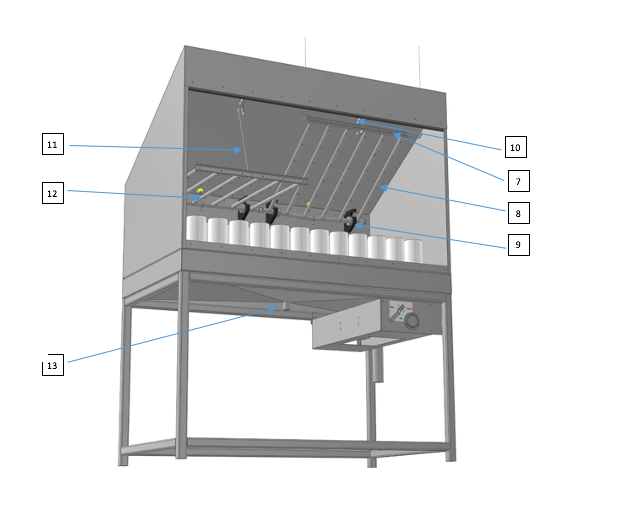The method uses the motility and sedimentation rate of nematodes. When (infected) soil / plant material (samples) are in contact with water the nematodes will crawl out of the material into the water and settle. Samples are placed in an extraction sieve. This extraction sieve is equipped with a filter and a receptacle underneath. This assembly is placed under a special mist generator. The constant fine mist over the samples prevents oxygen deficiency.
Plant juices, decomposition products and micro-organisms do not accumulate because they are discharged with the overflowing water. The nematodes present in the samples will be entrained with the water and will sink through the filter. The water with nematodes is collected in the container under the filter and can be used for further research.





Parts
1. Water supply
2. Extraction sieves with receptacle tray
3. Receptacle container
4. Water filter
5. Water regulation handle
6. Water pressure gauge
7. Spray arm
8. Mist generator
9. Clamp for spray arm
10. Bracket for lifting the spray bar
11. Balancing wire
12. Water connection in spray bar
13. Water disposal connector
14. Pressure regulator knob
15. Pressure regulator
16. Positioning plates with fixed positions for the extraction sets
17. “Anti drip” doors
The extraction chamber has 2 spray bars with 36 mist generators each. This gives a total of 72 fog generators for 72 sieves. The spray bars can be used simultaneously or separately. The bottom of the extraction chamber is a large receptacle where access water is collected. Due to the conical shape of the collection tray, the water is drained immediately. The collection tray has plates on which fixed positions are provided for placing the sieve sets.
As a result, the sieves cannot move and are located directly under the mist generators. The mist that falls next to the extraction screens is collected in the collection tray and is discharged through the drain.
The extraction box has 2 “anti-drip” sliding doors so that the mist remains in the extraction box.


